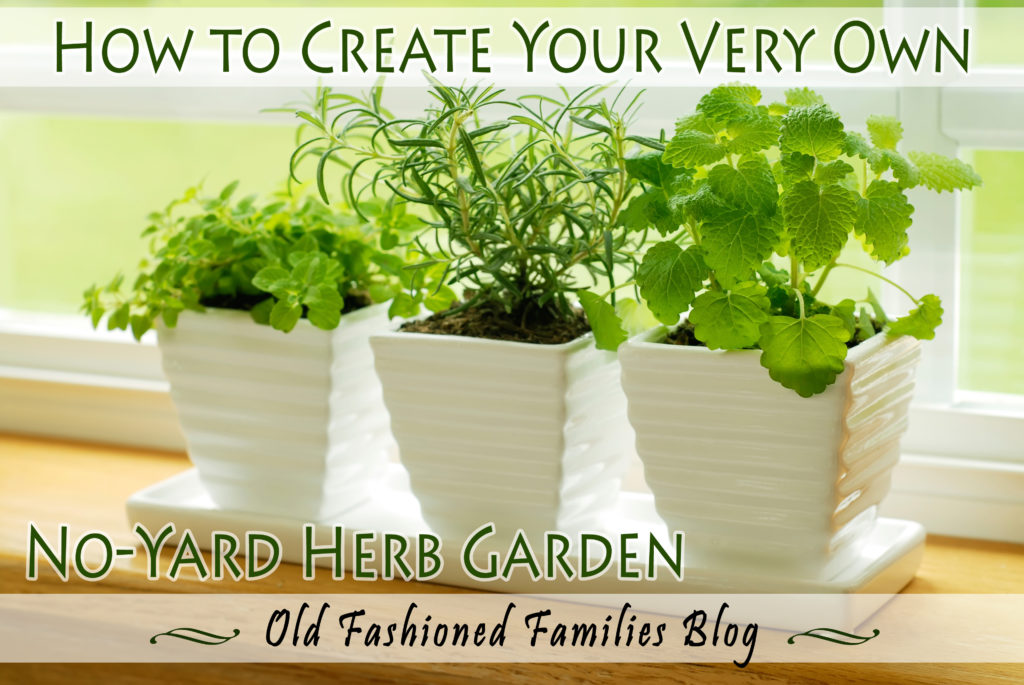I thought we could talk about some gardening options for people with no yard space. Whether you live in an apartment, town house, or are renting a property and the landlord doesn’t want you digging up the yard, gardening in pots is a great way to get herbs and veggies when you don’t have the yard to support it!
Potted plants can be a great way to get items from your garden through the fall months as well. After all, it is just around the corner. You can leave them out, weather permitting, and easily grab the pot and bring it in when things start getting frosty outside. Of course, this will be much easier with some plants than others.
Today I want to talk about some herbs that will be easy to grow in a pot. We can revisit this topic with veggies a little later. Here are 5 herbs you can easily grow in pots and use all year long!
Basil
Basil can add great flavor to soups, pizza, pasta, etc. The basic necessities for growing basil are a planter (about 6 inches), soil, fertilizer, and of course basil seedlings.
Here are the main things you need to know for growing basil indoors: First, basil isn’t a fan of the cold (kind of like me) so the plants need to be kept at about 70 or above. Basil is watered from the bottom up, so don’t get the plant wet. The easiest way to do this would be to water through the tray at the bottom of the pot and allow it to soak up through the soil. Also, you need to make certain the plant gets at least 6 hours of sunlight a day, and rotate it daily so that the whole plant is getting some rays.
If you need some more tips on how to grow some great basil, you can find that here.
Parsley
This is going to be a really easy one. You’re going to need the same supplies as you did for basil, but the upkeep is more simple. Parsley is good to go in weather between 40-80 degrees, so in the fall months you can keep it outside. In later months, I would recommend to bring it in at night, though, in case of frost. The most important thing to remember about parsley is that you want to keep the soil moist, and not let it dry out. It doesn’t even need to be in direct sunlight all day—partial shade is just fine.
You can find additional information about growing and harvesting your parsley here.
Oregano
Some people will actually suggest that you always grow your oregano in a pot to keep it from spreading too much. It’s going to be pretty easy to point you in the right direction with this one… The pot doesn’t matter much, nor does the soil, as long as it is well-drained. You don’t have to add fertilizer unless you think your oregano needs it, and even then you only need to do it every couple of weeks. This herb will do just fine at room temperature, right around 70 degrees. Keep it in the sun for 6-8 hours a day, and be sure to start trimming it as soon as its about 6″ tall.
You can find more details on indoor oregano care here.
Chives
This one might be my favorite, because I love the subtle onion flavor of chives, and growing them is actually really simple! You can plant them about 1/2″ deep, about 8″ apart, and make sure to add sand or lava rock on the bottom to help with drainage. You are welcome to use compost in this soil as well. If you water your plant regularly, you will get better leaves, and more of them! For a more potent taste, make sure you try to keep the flowers off your plant. Trim them as they pop up and enjoy the delicious leaves!
For more info on chive plants, including pest control, click here.
Thyme
For thyme, its good to use a clay or terra cotta pot with good drainage at the bottom so it can dry out between watering. For this herb, you can use a concoction of sand, soil, and peat moss that will provide nutrients and support drainage. Thyme needs to stay at 60 degrees or above, and get at least 6 hours of sun a day. The upkeep for thyme is very simple: you just trim as you go. If it starts to grow out of the bottom of the container, its time to either divide your plant or repot it!
For more on using and harvesting your thyme, you can look here.
I know there are a lot of people out there that wish they had a green thumb and a huge garden. Unfortunately, not everyone has the space. Pots can jump start gardening for those of you who don’t have your own yard quite yet. And, if you are gardening already, it can give you a few herbs to grow indoors as the colder seasons creep up on us. You can always transport your potted plants back out to your garden when things warm up again. Keep in mind this are just a few options. There are so many more options for an indoor herb garden!
Once you get your indoor garden going, check out our article on how to dry and preserve fresh herbs so they don’t go bad!


Leave a Reply